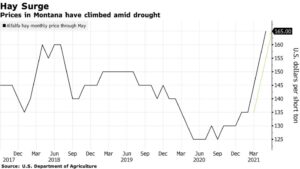Congress has quickly engaged in putting together potential aid packages for farmers that would more than double the Trump administration's $12 billion under the Farmer Bridge Assistance (FBA) Program.
Threat of Food Inflation Persists, as Sec. Vilsack Sees Prices Moderating
At the end of last week, Bloomberg News reported that, “Extreme weather is slamming crops across the globe, bringing with it the threat of further food inflation at a time costs are already hovering near the highest in a decade and hunger is on the rise.
Brazil’s worst frost in two decades brought a deadly blow to young coffee trees in the world’s biggest grower. Flooding in China’s key pork region inundated farms and raised the threat of animal disease. Scorching heat and drought crushed crops on both sides of the U.S.-Canada border. And in Europe, torrential rains sparked the risk of fungal diseases for grains and stalled tractors in soaked fields.
The Bloomberg article pointed out that, “No other industry is more at the mercy of sun, rain and heat than agriculture, where changes in the weather can upend a farmer’s fortunes overnight. It’s also an industry that’s become extremely globalized and concentrated, creating a precarious situation where an extreme weather event in one place is bound to have ripples everywhere.”
“The drought is also withering crops in Canada’s bread basket Prairie provinces and in the northern U.S., forcing farmers to take the rare step of of baling up their low-yielding wheat and barley stems to sell as livestock feed.

“Prices for the region’s spring wheat, the variety used to make flour for bagels and pizza crusts, recently touched the highest in more than eight years.”
Approximately 99% of spring #wheat production is within an area experiencing #drought, @usda_oce pic.twitter.com/VWcOw8pW2p
— Farm Policy (@FarmPolicy) July 22, 2021
Approximately 99% of durum #wheat production is within an area experiencing #drought, @usda_oce pic.twitter.com/a7GDNYbEFZ
— Farm Policy (@FarmPolicy) July 22, 2021
Last week’s article added that, “Dramatic images of inundated towns in Germany and Belgium this month are adding to a wetter-than-usual summer across much of Europe. Rain has taken its toll on grains, leading to harvest delays. That follows a spring of frosts which damaged crops from sugar beets to fruit trees, and devastated some vineyards in France and elsewhere.
“While European wheat output is actually expected to increase this year, a share of the harvest may end up switching from milling for bread products to feeding farm animals instead. That threatens shipments to North Africa, which relies on imports of high-quality grain.”
However, Bloomberg’s Mike Dorning and David Westin reported on Friday that, “Agriculture Secretary Tom Vilsack predicted the jump in U.S. food prices in June will quickly moderate despite rising concern about inflationary risks in the economy.
.@SecVilsack Expects 'Moderation' in Food Inflation https://t.co/rXOAjX3XPs
— Farm Policy (@FarmPolicy) July 23, 2021
“‘There are certain selective items in the grocery store folks may see for a period of time increased costs,’ Vilsack said Friday in an interview on Bloomberg Television’s ‘Balance of Power’ with David Westin. ‘We think this will even out as we begin to recover, as we begin to get the supply and demand in better balance.’
“U.S. food prices jumped 0.8% in June from May, double the pace of the prior two months. Meat and poultry prices surged 2.5% last month, according to the U.S. Department of Labor’s consumer price index. Still, food costs are up just 2.4% from a year earlier, while overall inflation was 5.4% for the period.”





